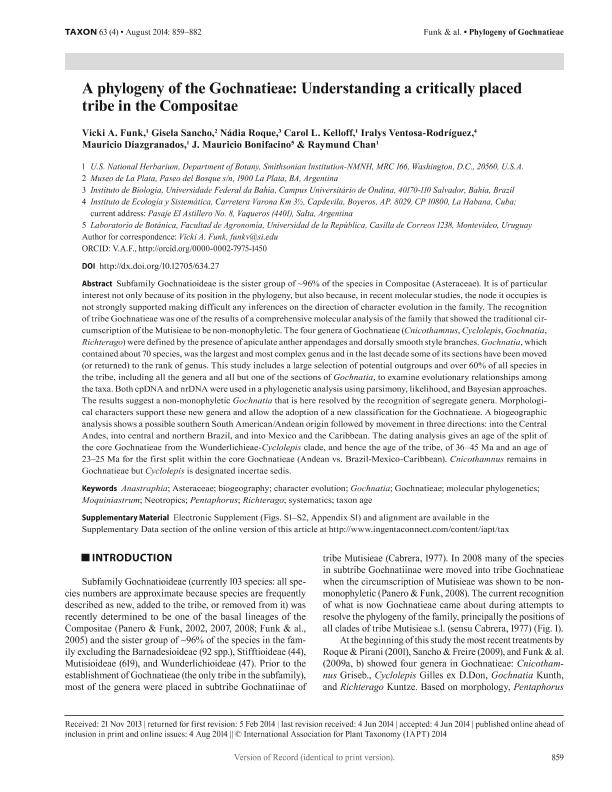Mostrar el registro sencillo del ítem
dc.contributor.author
Funk, Vicki
dc.contributor.author
Sancho, Gisela

dc.contributor.author
Roque, Nadia
dc.contributor.author
Kelloff, Carol L.
dc.contributor.author
Ventosa Rodriguez, Iralys
dc.contributor.author
Díaz Granados, Mauricio
dc.contributor.author
Bonifacino, J. Mauricio
dc.contributor.author
Chan, Raymund
dc.date.available
2018-01-12T15:15:07Z
dc.date.issued
2014-08
dc.identifier.citation
Ventosa Rodriguez, Iralys; Díaz Granados, Mauricio; Chan, Raymund; Bonifacino, J. Mauricio; Funk, Vicki; Kelloff, Carol L.; et al.; A phylogeny of the Gochnatieae: Understanding a critically placed tribe in the Compositae; International Association for Plant Taxonomy; Taxon; 63; 4; 8-2014; 859-882
dc.identifier.issn
0040-0262
dc.identifier.uri
http://hdl.handle.net/11336/33056
dc.description.abstract
Subfamily Gochnatioideae is the sister group of ~96% of the species in Compositae (Asteraceae). It is of particular interest not only because of its position in the phylogeny, but also because, in recent molecular studies, the node it occupies is not strongly supported making difficult any inferences on the direction of character evolution in the family. The recognition of tribe Gochnatieae was one of the results of a comprehensive molecular analysis of the family that showed the traditional cir-cumscription of the Mutisieae to be non-monophyletic. The four genera of Gochnatieae (Cnicothamnus, Cyclolepis, Gochnatia, Richterago) were defined by the presence of apiculate anther appendages and dorsally smooth style branches. Gochnatia, which contained about 70 species, was the largest and most complex genus and in the last decade some of its sections have been moved (or returned) to the rank of genus. This study includes a large selection of potential outgroups and over 60% of all species in the tribe, including all the genera and all but one of the sections of Gochnatia, to examine evolutionary relationships among the taxa. Both cpDNA and nrDNA were used in a phylogenetic analysis using parsimony, likelihood, and Bayesian approaches. The results suggest a non-monophyletic Gochnatia that is here resolved by the recognition of segregate genera. Morphologi-cal characters support these new genera and allow the adoption of a new classification for the Gochnatieae. A biogeographic analysis shows a possible southern South American/Andean origin followed by movement in three directions: into the Central Andes, into central and northern Brazil, and into Mexico and the Caribbean. The dating analysis gives an age of the split of the core Gochnatieae from the Wunderlichieae-Cyclolepis clade, and hence the age of the tribe, of 36–45 Ma and an age of 23–25 Ma for the first split within the core Gochnatieae (Andean vs. Brazil-Mexico-Caribbean). Cnicothamnus remains in Gochnatieae but Cyclolepis is designated incertae sedis.
dc.format
application/pdf
dc.language.iso
eng
dc.publisher
International Association for Plant Taxonomy

dc.rights
info:eu-repo/semantics/openAccess
dc.rights.uri
https://creativecommons.org/licenses/by-nc-sa/2.5/ar/
dc.subject
Anastraphia
dc.subject
Asteraceae
dc.subject
Biogeography
dc.subject
Character Evolution
dc.subject
Gochnatia
dc.subject
Gochnatieae
dc.subject
Molecular Phylogenetics
dc.subject
Moquiniastrum
dc.subject
Neotropics
dc.subject
Pentaphorus
dc.subject
Richterago
dc.subject
Systematics
dc.subject
Taxon Age
dc.subject.classification
Otras Ciencias Biológicas

dc.subject.classification
Ciencias Biológicas

dc.subject.classification
CIENCIAS NATURALES Y EXACTAS

dc.title
A phylogeny of the Gochnatieae: Understanding a critically placed tribe in the Compositae
dc.type
info:eu-repo/semantics/article
dc.type
info:ar-repo/semantics/artículo
dc.type
info:eu-repo/semantics/publishedVersion
dc.date.updated
2018-01-08T18:41:24Z
dc.journal.volume
63
dc.journal.number
4
dc.journal.pagination
859-882
dc.journal.pais
Austria

dc.journal.ciudad
Viena
dc.description.fil
Fil: Funk, Vicki. Smithsonian Institution. Washington; Estados Unidos
dc.description.fil
Fil: Sancho, Gisela. Consejo Nacional de Investigaciones Científicas y Técnicas; Argentina. Universidad Nacional de La Plata. Facultad de Ciencias Naturales y Museo; Argentina
dc.description.fil
Fil: Roque, Nadia. Universidade Federal da Bahia; Brasil
dc.description.fil
Fil: Kelloff, Carol L.. Smithsonian Institution. Washington; Estados Unidos
dc.description.fil
Fil: Ventosa Rodriguez, Iralys. Instituto de Ecología y Sistemática. La Habana; Cuba
dc.description.fil
Fil: Díaz Granados, Mauricio. Smithsonian Institution. Washington; Estados Unidos
dc.description.fil
Fil: Bonifacino, J. Mauricio. Universidad de la República; Uruguay
dc.description.fil
Fil: Chan, Raymund. Smithsonian Institution. Washington; Estados Unidos
dc.journal.title
Taxon

dc.relation.alternativeid
info:eu-repo/semantics/altIdentifier/doi/http://dx.doi.org/10.12705/634.27
dc.relation.alternativeid
info:eu-repo/semantics/altIdentifier/url/http://www.ingentaconnect.com/content/iapt/tax/2014/00000063/00000004/art00013
Archivos asociados
